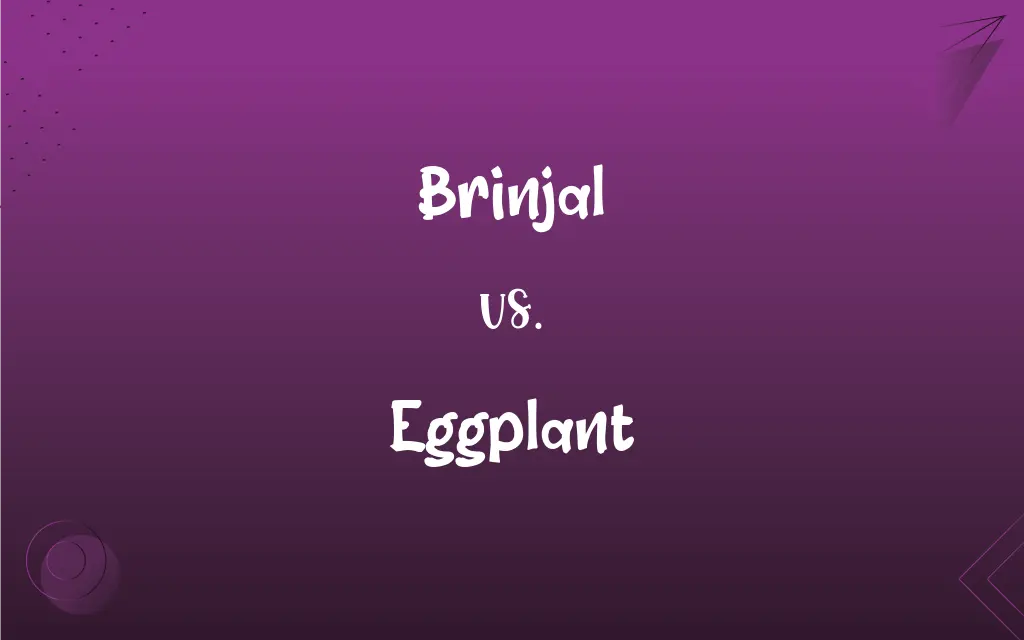Brinjal vs. Eggplant: What's the Difference?
Edited by Janet White || By Harlon Moss || Updated on June 9, 2024
Brinjal and Eggplant refer to the same purple vegetable; "Brinjal" is commonly used in South Asia, while "Eggplant" is the term used in North America.

Key Differences
Brinjal and Eggplant are two names for the same vegetable, predominantly distinguished by regional language preferences. Brinjal is the term most familiar in South Asian countries, like India, Bangladesh, and Pakistan. Within these regions, when people discuss this vegetable, they typically refer to it as Brinjal, a word rooted in regional languages. Eggplant, conversely, is the name primarily used in North American regions, including the United States and Canada. When American or Canadian chefs, gardeners, or shoppers talk about this dark purple vegetable, they'll most often use the term Eggplant.
Interestingly, other parts of the world have their own terms for this vegetable as well. In the UK and Australia, it's often called an "aubergine." But regardless of the term—be it Brinjal, Eggplant, or Aubergine—the vegetable itself remains the same, known scientifically as Solanum melongena.
Both Brinjal and Eggplant are used in a variety of dishes, spanning diverse cuisines. Whether you're making a South Asian curry using Brinjal or an Italian dish with Eggplant parmesan, you're cooking with the same delightful vegetable. Its versatility and global appreciation make it a favorite in kitchens around the world.
Comparison Chart
Regional Usage
Preferred in South Asia
Preferred in North America
Etymology
Derived from regional languages of South Asia
Named for its egg-like shape in some varieties
ADVERTISEMENT
Synonym
Aubergine in some regions
Aubergine in some regions
Scientific Name
Solanum melongena
Solanum melongena
Culinary Usage
Used in South Asian cuisines
Featured in North American and European dishes
Brinjal and Eggplant Definitions
Brinjal
A versatile ingredient prominent in South Asian cuisines.
Brinjal bharta is a popular dish in Indian households.
Eggplant
A common ingredient in Mediterranean and North American dishes.
Eggplant parmesan is a classic Italian-American dish.
ADVERTISEMENT
Brinjal
Brinjal is a purple, glossy-skinned vegetable.
I added slices of Brinjal to the curry for extra flavor.
Eggplant
Eggplant is a dark purple vegetable with a unique texture and taste.
I grilled the Eggplant slices for the salad.
Brinjal
The South Asian term for what's known as Eggplant in North America.
In the local market, fresh Brinjal was on sale.
Eggplant
Known as Brinjal in South Asia and Aubergine in the UK and Australia.
The recipe calls for one large Eggplant.
Brinjal
Often used in dishes like curries, stir-fries, and roasted preparations.
For dinner, we had a spicy Brinjal curry.
Eggplant
Used in various culinary preparations, from roasting to frying.
The creamy Eggplant dip was a hit at the party.
Brinjal
A member of the nightshade family, related to tomatoes and peppers.
Brinjal, like its cousin the tomato, thrives in the summer.
Eggplant
A source of vitamins, minerals, and beneficial plant compounds.
Including Eggplant in your diet can offer numerous health benefits.
Brinjal
An aubergine or eggplant.
Eggplant
A plant (Solanum melongena) native to India, cultivated for its edible, glossy, usually ovoid fruits that are chiefly purple but can be white, yellow, or green.
Brinjal
Hairy upright herb native to southeastern Asia but widely cultivated for its large glossy edible fruit commonly used as a vegetable
Eggplant
A fruit of this plant. Also called aubergine.
Eggplant
A blackish purple.
FAQs
Why is it called an Eggplant in North America?
The term "Eggplant" originated from early varieties that resembled eggs in shape and color.
Can you substitute Brinjal for Eggplant in recipes?
Absolutely, since they are the same vegetable.
Is Eggplant parmesan made with actual eggs?
The name refers to the vegetable, but the dish often involves breadcrumbs and cheese.
Are there different varieties of Brinjal/Eggplant?
Yes, they come in different sizes, shapes, and colors, from purple to white.
What's the nutritional value of an Eggplant?
Eggplant is low in calories but rich in fiber, vitamins, and minerals.
Why might someone in India be unfamiliar with the term Eggplant?
In India, the common term is Brinjal, so the word Eggplant might be less recognized.
Can Brinjal be eaten raw?
While it can be, Brinjal is usually cooked to enhance its flavor and texture.
Are all Brinjal varieties purple?
No, while purple is common, there are white, green, and striped Brinjals.
How do you reduce the bitterness of an Eggplant?
Salting sliced Eggplant and letting it sit can draw out some bitterness.
Can you roast an entire Eggplant?
Yes, whole roasted Eggplant is a preparation method in various cuisines.
What pairs well with Brinjal in dishes?
Tomatoes, garlic, onions, and spices complement Brinjal's flavor.
How long does an Eggplant last in the fridge?
Fresh Eggplant can last for about a week if stored properly.
Can people with nightshade sensitivities eat Eggplant?
It's best to avoid Eggplant if one has a nightshade sensitivity or allergy.
Is Brinjal commonly used in Indian cuisine?
Yes, Brinjal is a staple in various Indian dishes.
Why is Eggplant considered a "nightshade"?
It belongs to the nightshade family, which includes tomatoes, peppers, and potatoes.
Is Brinjal good for health?
Yes, Brinjal is nutritious and offers various health benefits.
Are Brinjal and Eggplant the same?
Yes, Brinjal and Eggplant refer to the same vegetable.
Is Eggplant's skin edible?
Yes, the skin of the Eggplant is edible and nutritious.
What's the difference between Brinjal and Aubergine?
They're different regional names for the same vegetable.
Which cuisines prominently feature Brinjal?
South Asian, Mediterranean, Middle Eastern, and more.
About Author
Written by
Harlon MossHarlon is a seasoned quality moderator and accomplished content writer for Difference Wiki. An alumnus of the prestigious University of California, he earned his degree in Computer Science. Leveraging his academic background, Harlon brings a meticulous and informed perspective to his work, ensuring content accuracy and excellence.
Edited by
Janet WhiteJanet White has been an esteemed writer and blogger for Difference Wiki. Holding a Master's degree in Science and Medical Journalism from the prestigious Boston University, she has consistently demonstrated her expertise and passion for her field. When she's not immersed in her work, Janet relishes her time exercising, delving into a good book, and cherishing moments with friends and family.































































